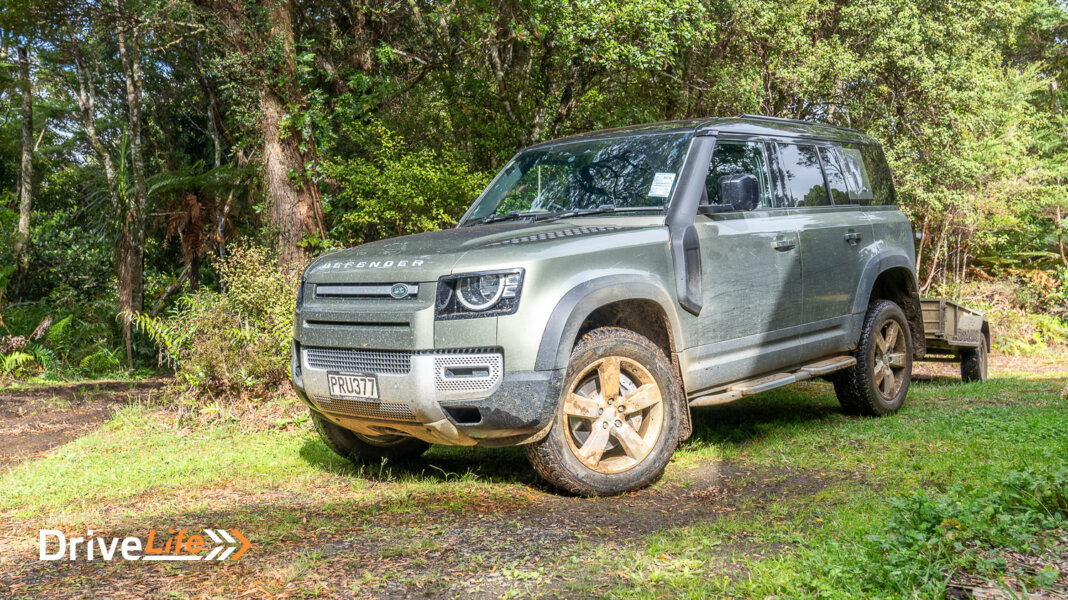It’s been a long time since 2020 when we last reviewed the Land Rover Defender 110. The car impressed us then and while we do our best to review a car in the conditions it’s designed for, that doesn’t always happen.
For that Defender review, we managed to get the 4WD out onto the Red Rocks road, which showed how good it was but also showed that it had a lot more potential. Come 2024, I needed to travel to my 40-acre block in the remote backblocks of the Ahipara Gumfields to do some much-needed work on our “road”. We’d taken cars up on this road before, like the Mercedes-Benz GLC and Ford Ranger, but since those drives, the road is a lot worse, with trees growing over and huge mud ruts to try and get through to access my bach.
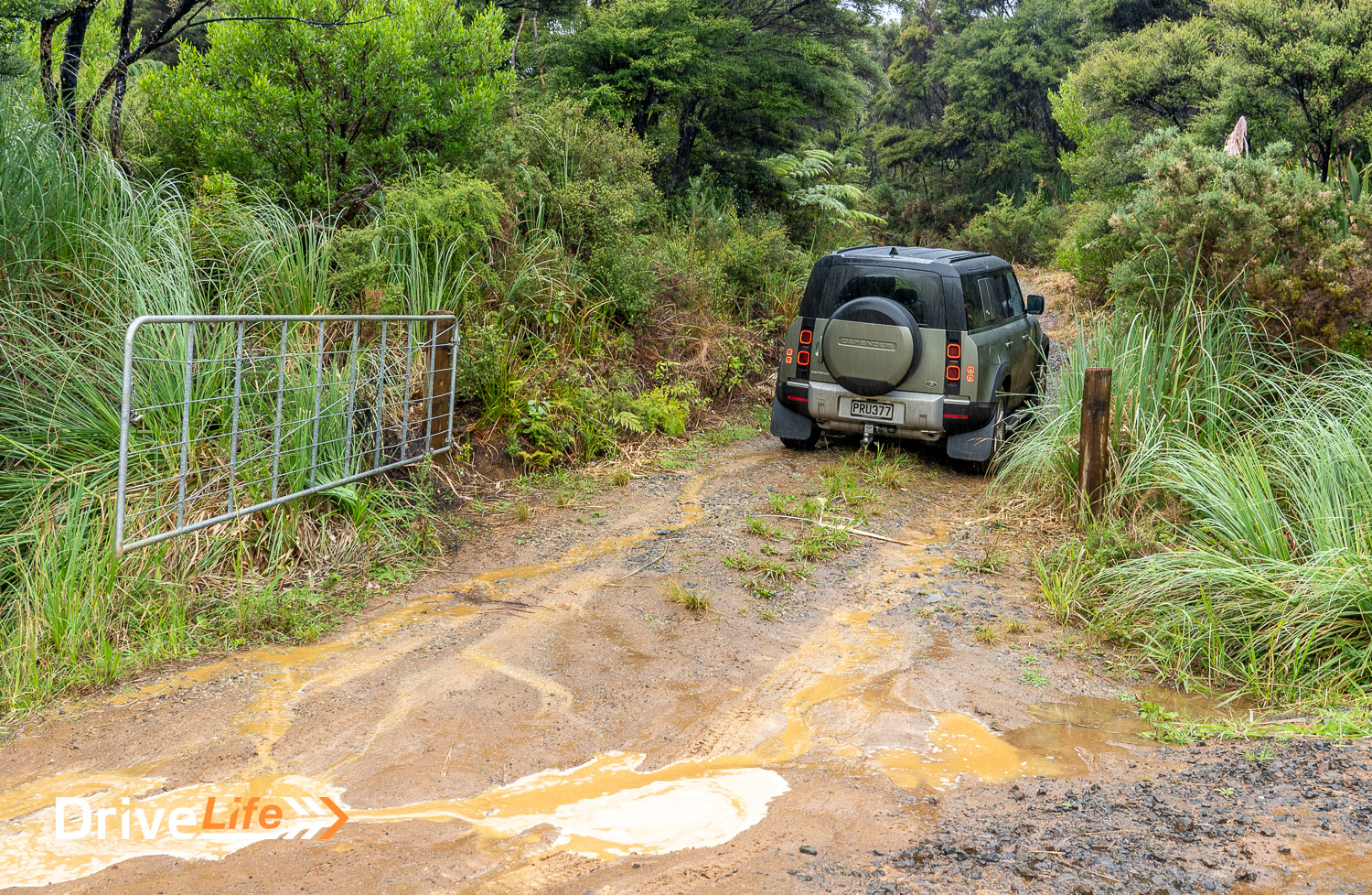
So first on my list for vehicles was one that would be comfy for the 6-hour drive from Auckland, but also with premium towing and off-road capabilities. The Defender came at the top of the list, so Land Rover New Zealand organised a 5-door 110 model for me to use – fully knowing where we would be taking it.
Picking up our test car in Auckland reminded me just how awesome this 4WD looks. Honestly, for me, this is the best-looking offroad car money can buy. Finished in Pangea Green, our test car oozed style, aggressiveness and off-road prowess all in one design. It just works. Time and again after parking the Defender, I would always enjoy seeing it on my return. The stance the Defender 110 projects is stunning.
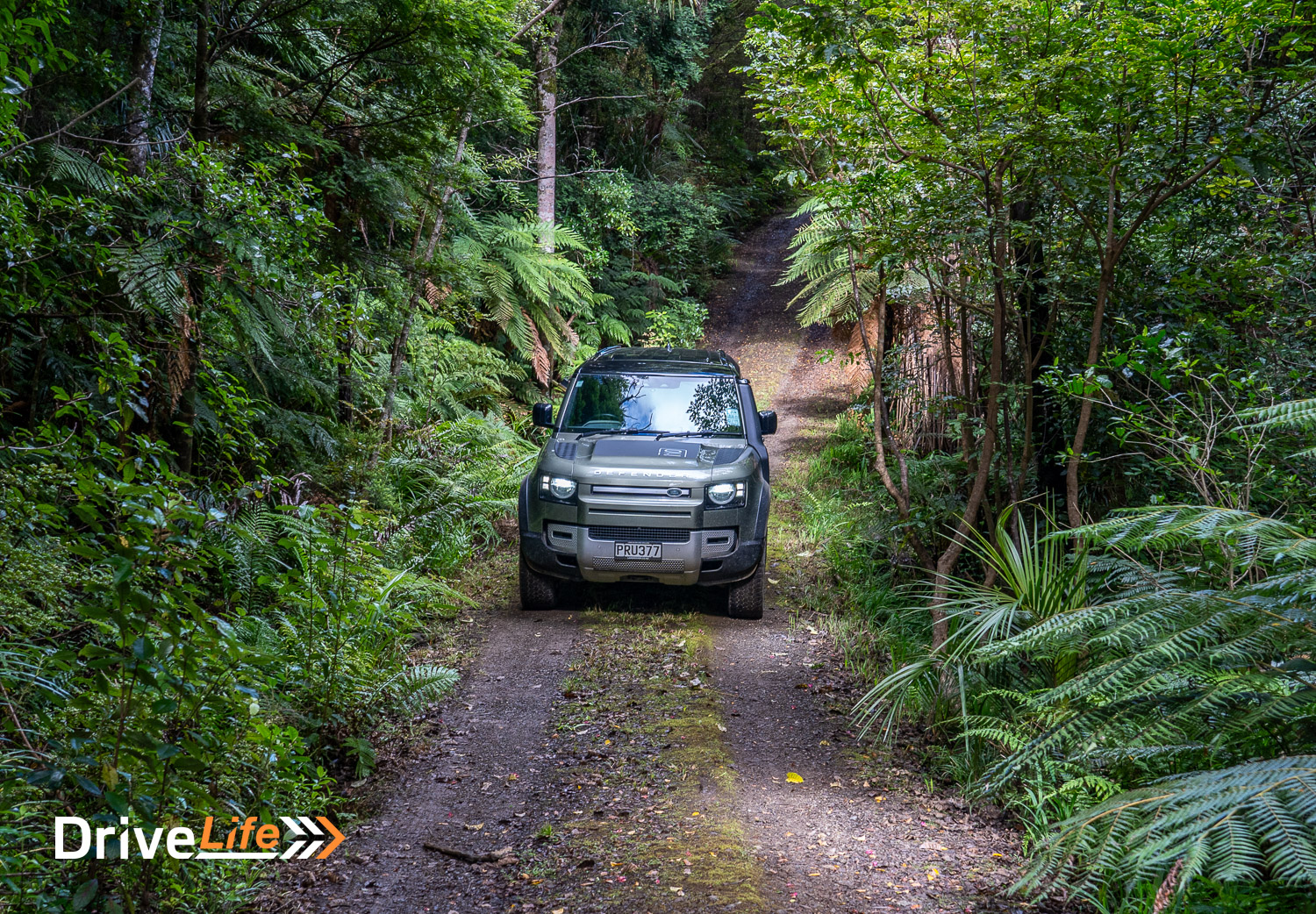
Loading up my suitcase – full of power tools, so right on the weight limit for a flight – was easy, thanks to the buttons in the boot of the Defender, allowing me to lower (or raise) the suspension for easier loading up. I’d end up using that button more than I thought over my week with the car.
With 625km of range and a full tank of diesel, the 110 and I hit the road towards the Far North of New Zealand. Unlike the new Ranger and Everest, the Defender has a 3.0-litre straight-6 turbo-diesel (instead of a V6) with a whopping 650Nm of torque. I’d be needing that pulling power in the days to come.
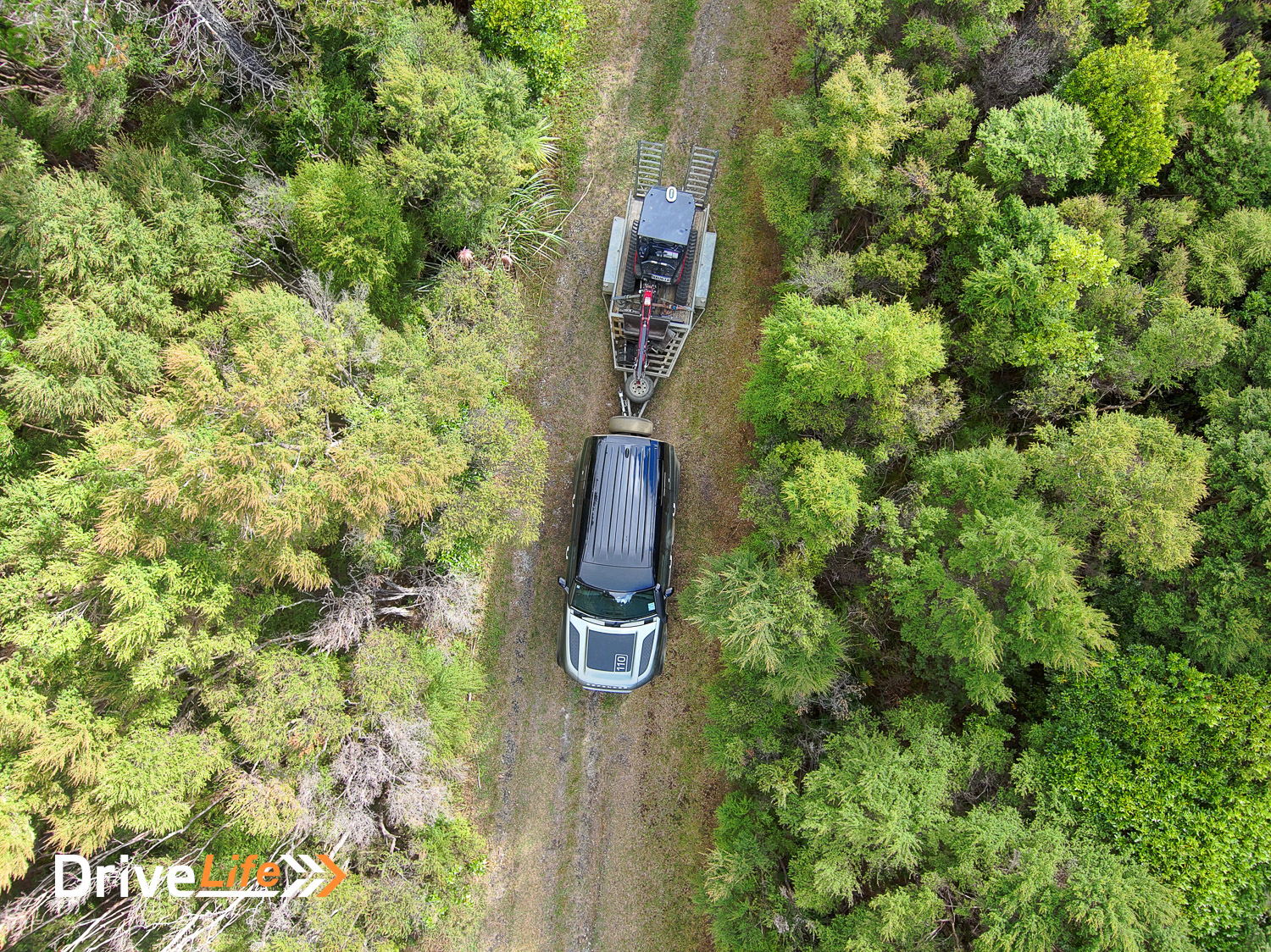
But the numbers don’t relate to how civilised this engine is; on the highway, it’s whisper-quiet, and an absolute dream to drive in motorway conditions. Go to pass some slower traffic, and the engine takes on a howl reminiscent of a 6-cylinder petrol motor, not a diesel. I had to explain to the passengers that I had with me now and then that this wasn’t a petrol car – they all assumed it was. It’s that quiet.
Heading north and due to the Brenderwyns/SH1 being closed, opted for the Mangawhai detour, and what a mistake that was. For some crazy reason, with SH1 closed and nearly all traffic heading through Mangawhai and up the coast, someone decided it would be a great time to do roadworks, with temporary traffic lights dotted along the way. The traffic was chaotic at best, and it took so much longer to get back onto SH1 going this route.
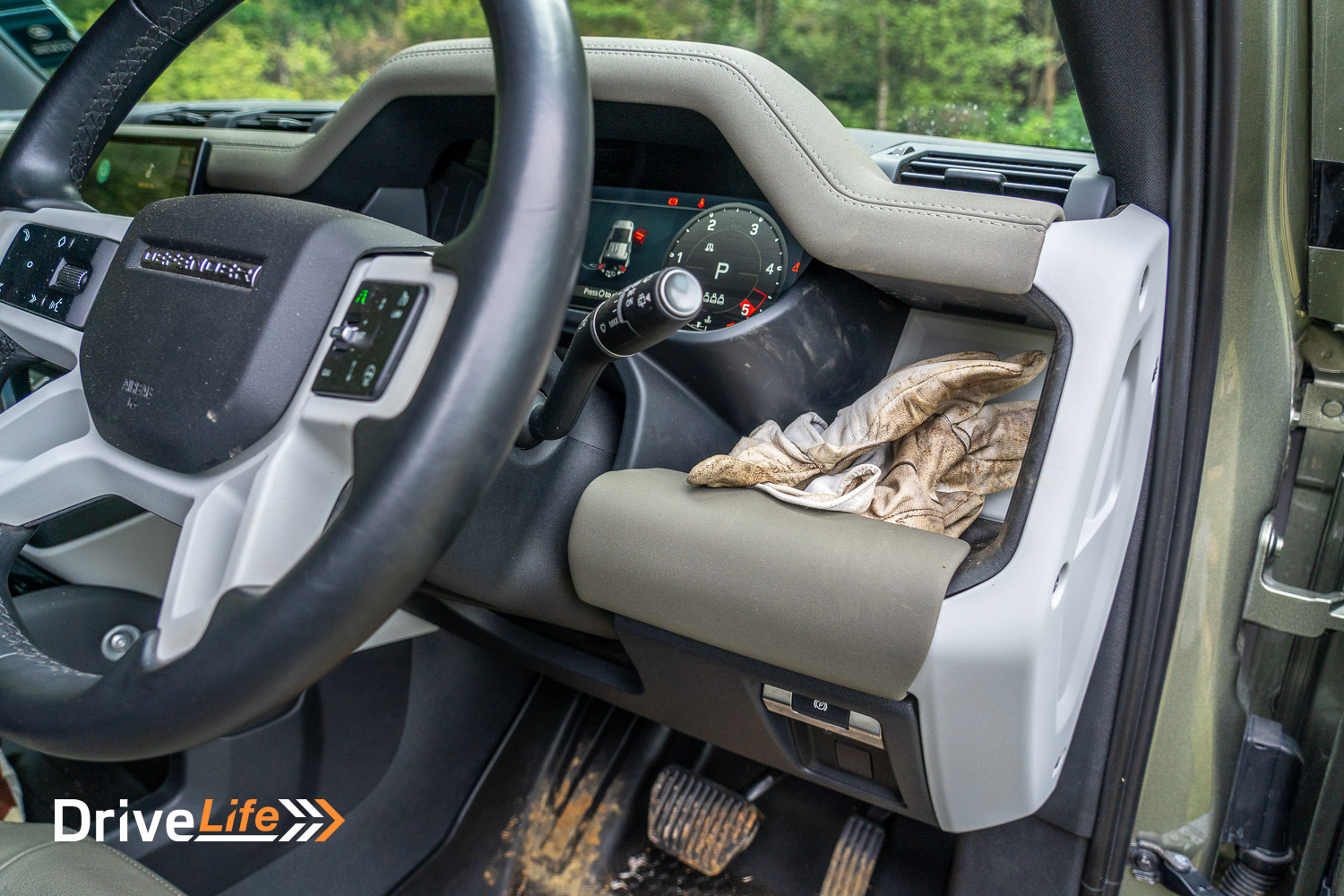
Thankfully, visibility is first-rate in the Defender; I thought those panelled C-pillars would block a lot of my three-quarter vision, but they barely affected it at all. Naturally, there is blind-spot monitoring in place as well.
Ride quality on those B roads is excellent; fitted with air suspension, the car smashes any bumps out before they get into the cabin. Wind noise and road noise are low as well, another surprise. Even those chunky Goodyear Wrangler tyres (another much-needed item for this trip) had little thrumming coming from them on the open road, no matter what the surface.
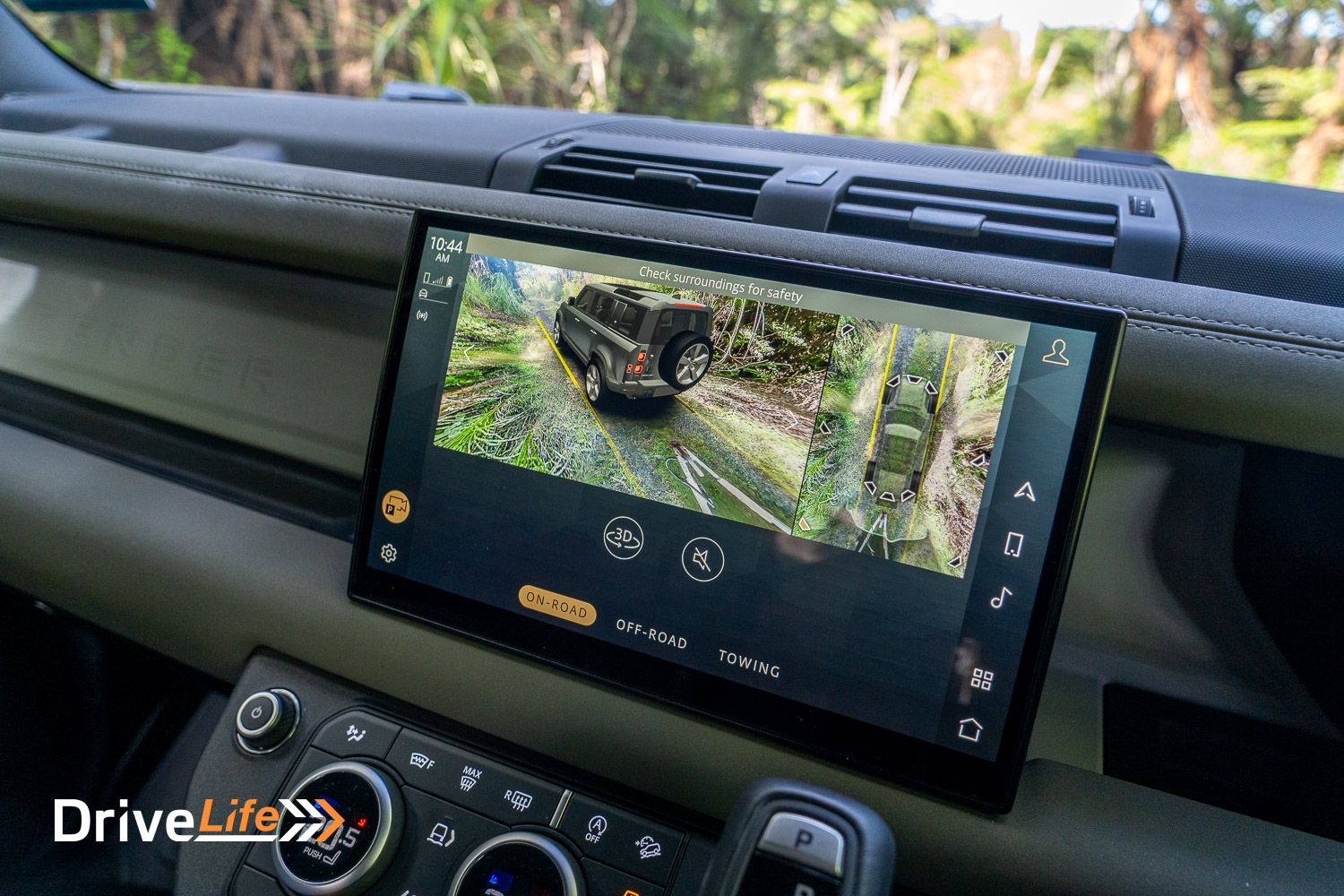
Since SH1 is closed south of Kaitaia on the Mangamuka Ranges, that meant another detour, and another mistake as I decided to take the SH10 bypass via Kerikeri and Coopers Beach. This highlighted just how bad New Zealand drivers are; with a crazy-low 80km/h limit for most of this road, drivers ahead of me were doing 60km/h and then braking when going uphill around a corner. On the way back, I’d be taking a different route to get back to Auckland thank you very much.
Getting to Kaitaia, I headed west to get to Ahipara, realising that since I was here last, someone at the council decided they would go for a Guinness Book of Records for the most speed bumps in a small coastal town. They are everywhere! Completely out of the blue in a seemingly pointless part of the road, there will be a speed bump. Another crazy sign of the times. Still, the suspension on the Defender soaked these up easily.
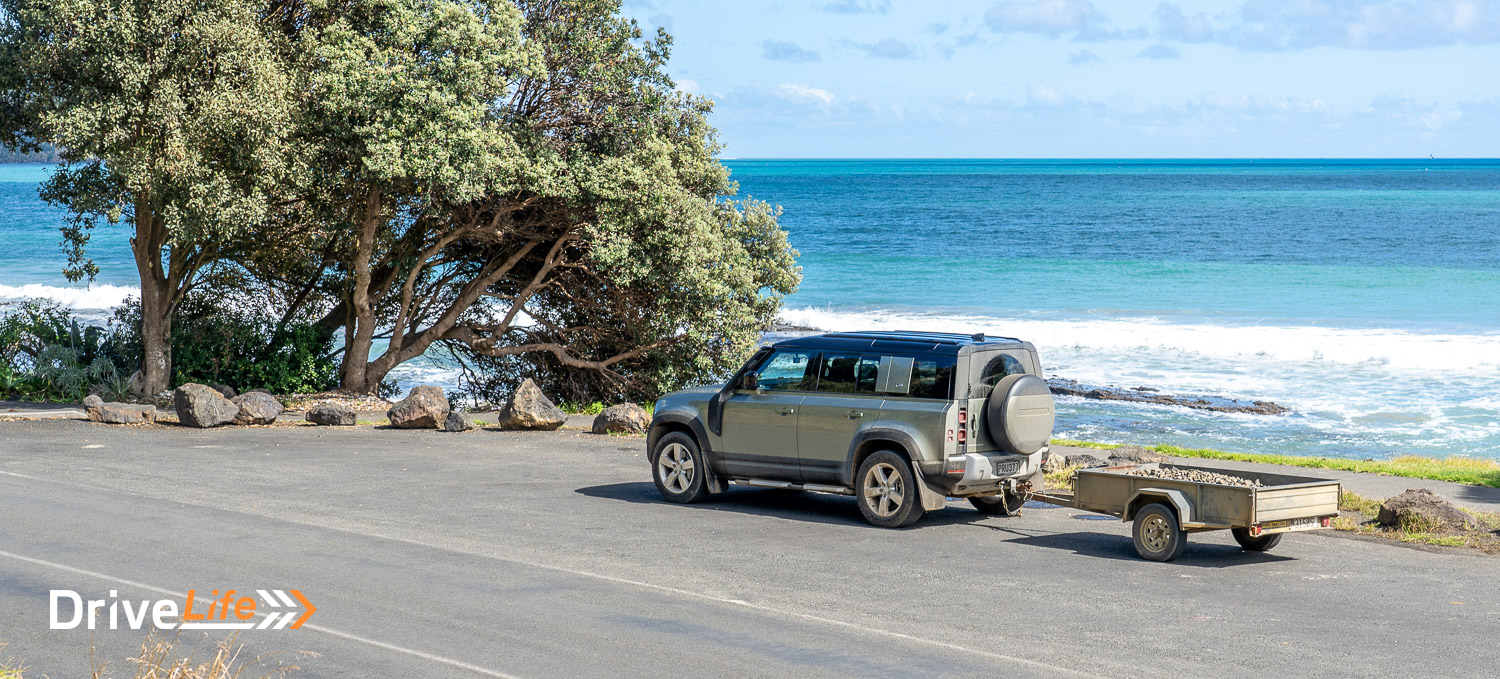
Leaving Ahipara, I then started the climb up the hill, above the world-famous surfing spot that is Shipwreck Bay, with its left-point break. This is where the seal ends, and the Defender would never be as clean again. I set the Drive Mode to Grass/Gravel/Snow as I left the seal, and was pleasantly surprised to find the car rode over the ruts on corners very, very well. Lots of cars skip over ruts and send the car sideways or set up jolting through the cabin, but the Defender’s air suspension coped with them beautifully.
I did find that with the mode on Grass/Gravel/Snow, the traction control would kick in pretty early, dialling off engine power until traction was regained. It was no drama and required no input from the driver, so that was fine with me.
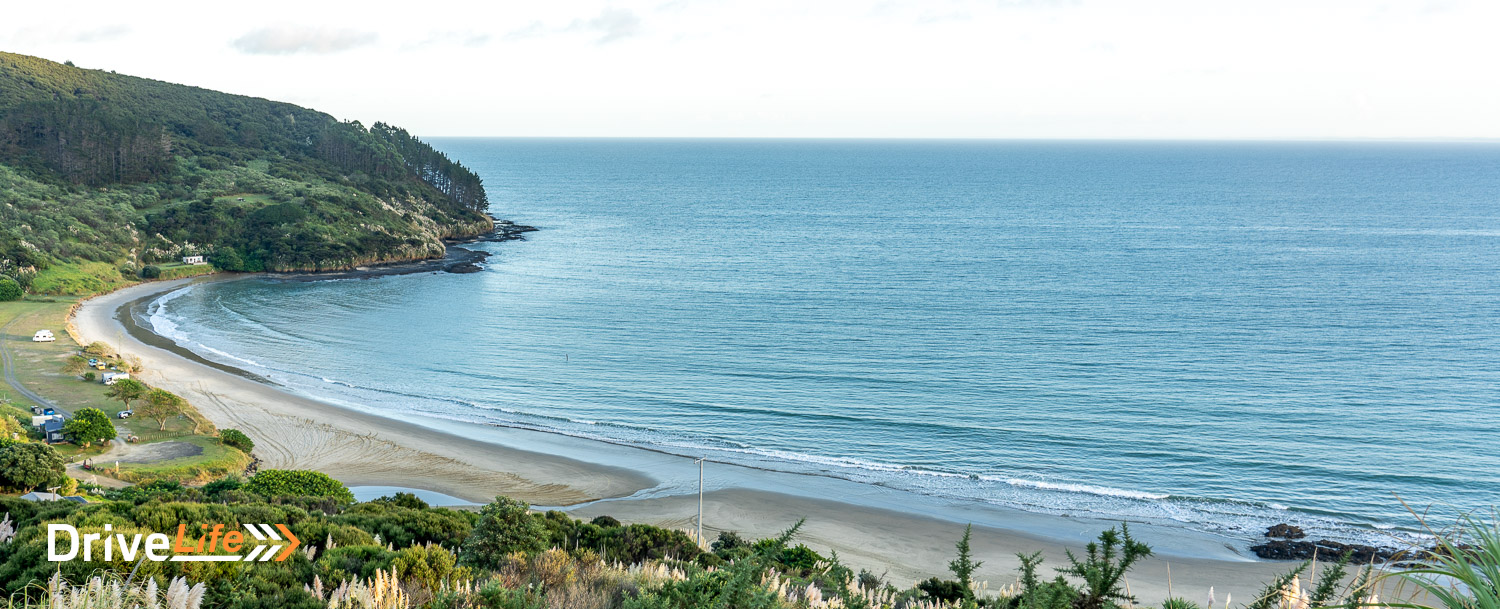
After another 15 minutes, I got to our private “road”. This is where the suspension would need to be at its highest, to stop the diff smashing into the ground. Seconds later, the car was set at its highest level, meaning using the side steps to get in and out, as it’s pretty high off the ground at this point. Cruising along our goat track of a road, the ride quality is still impressive. I’d call the Defender the best riding car I had taken on that road to date.
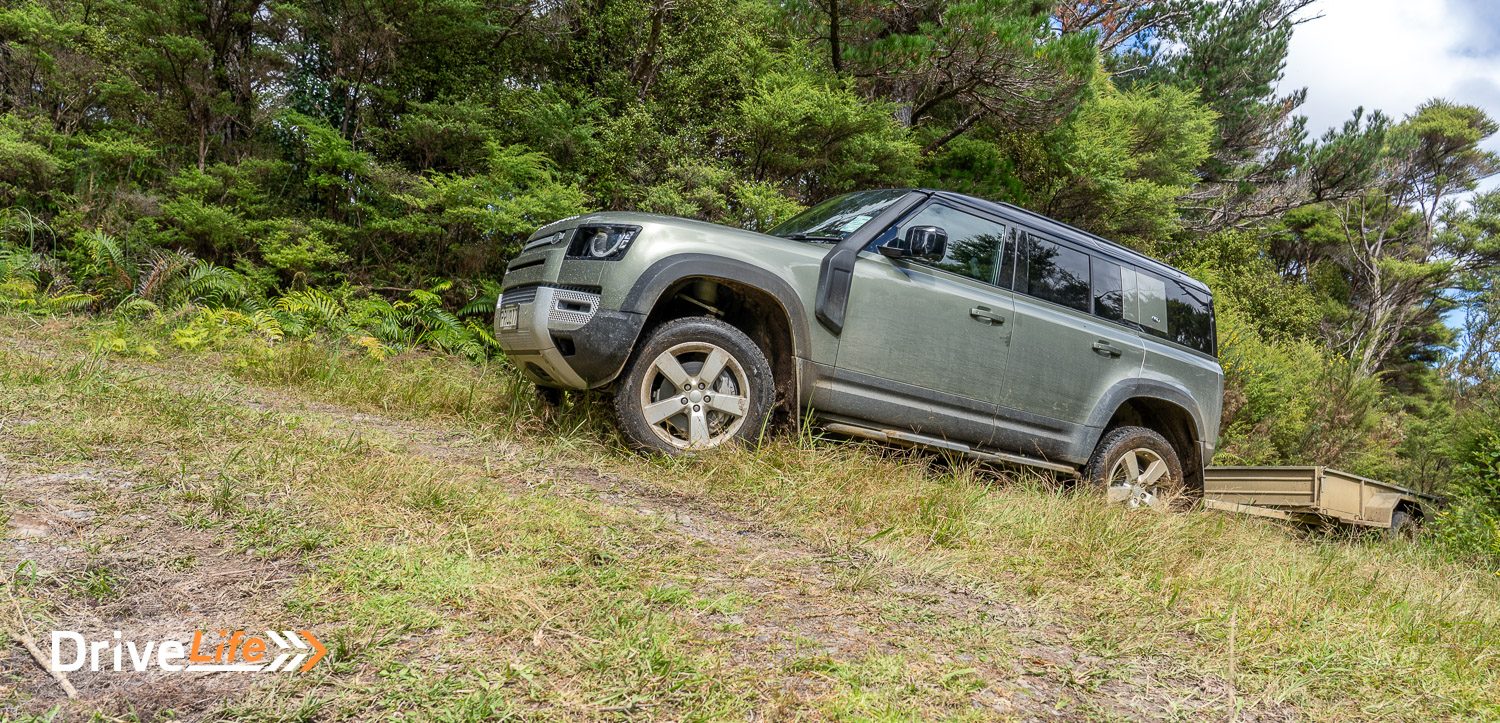
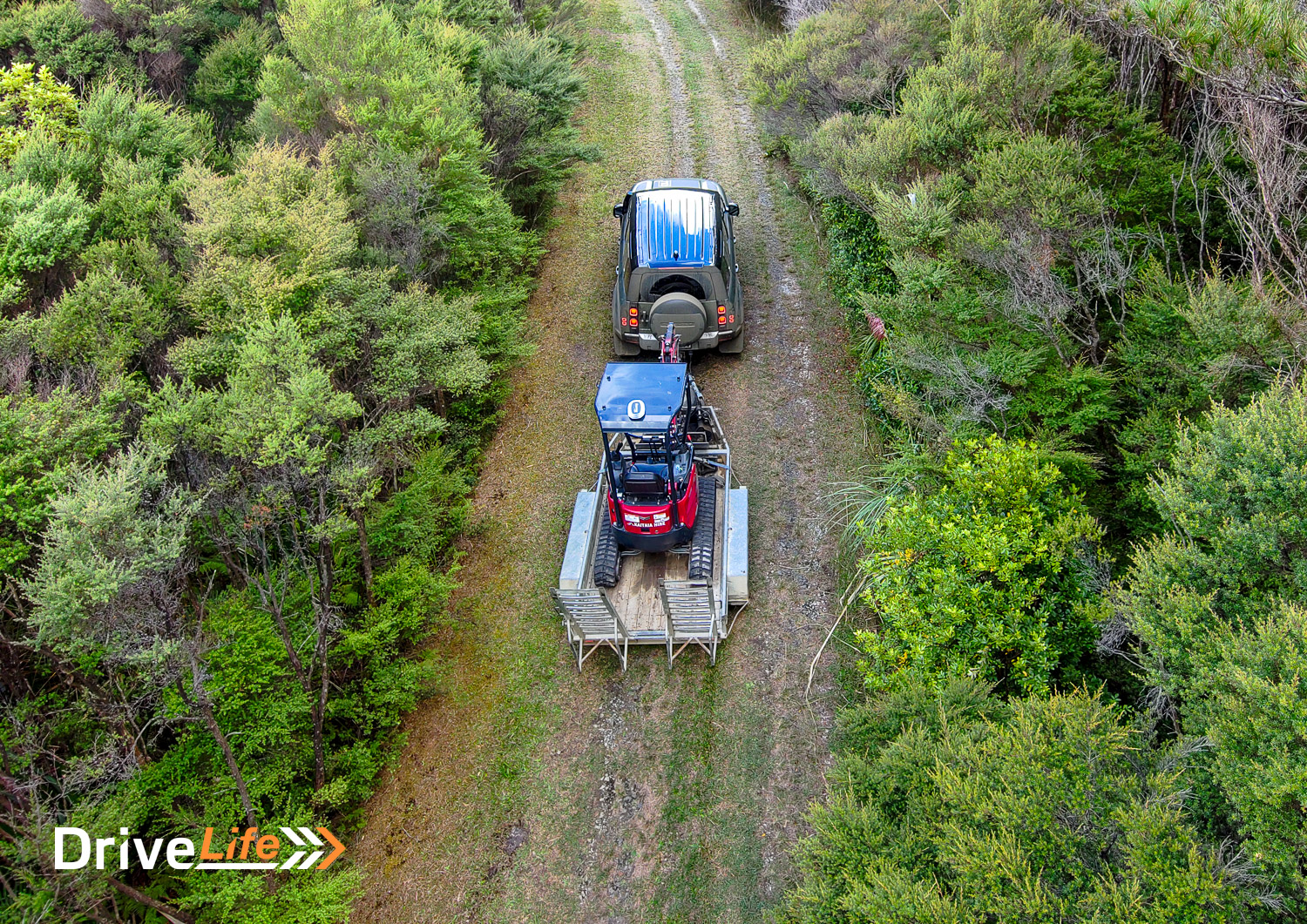
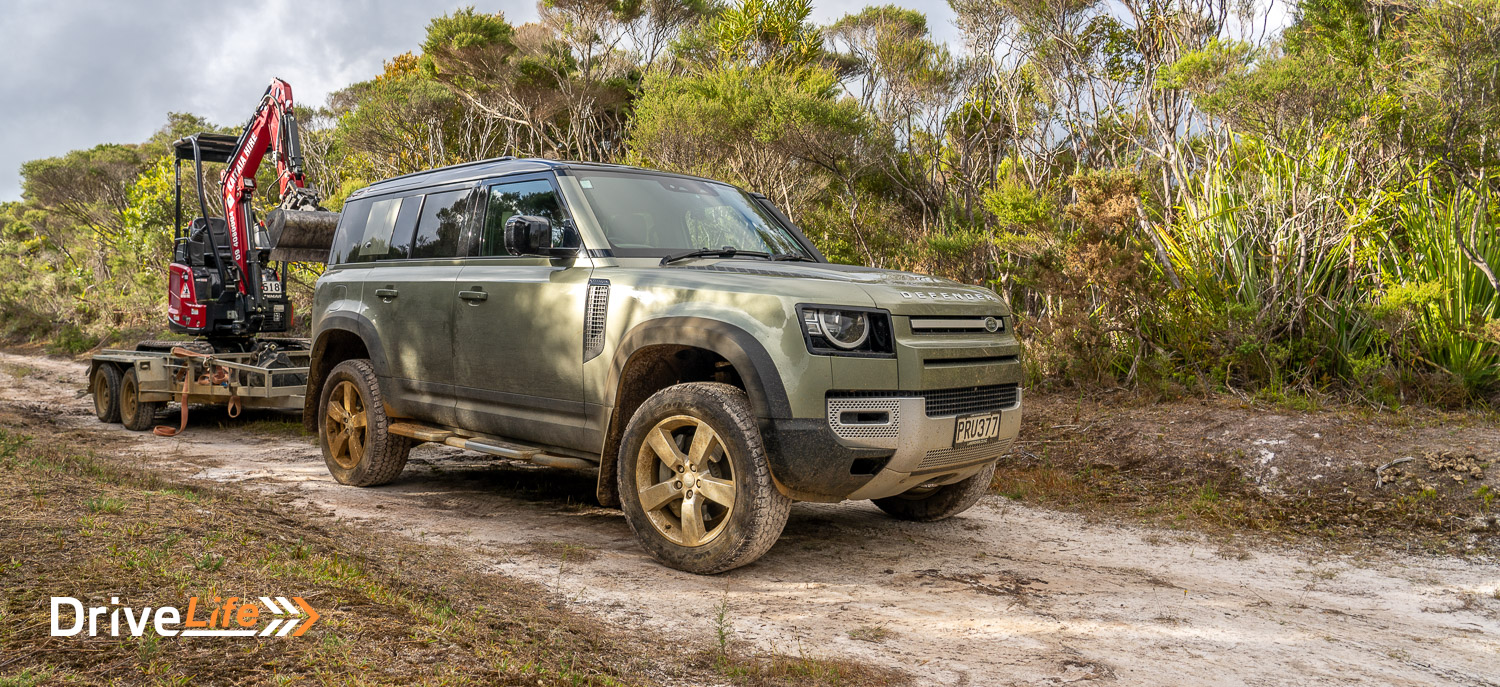
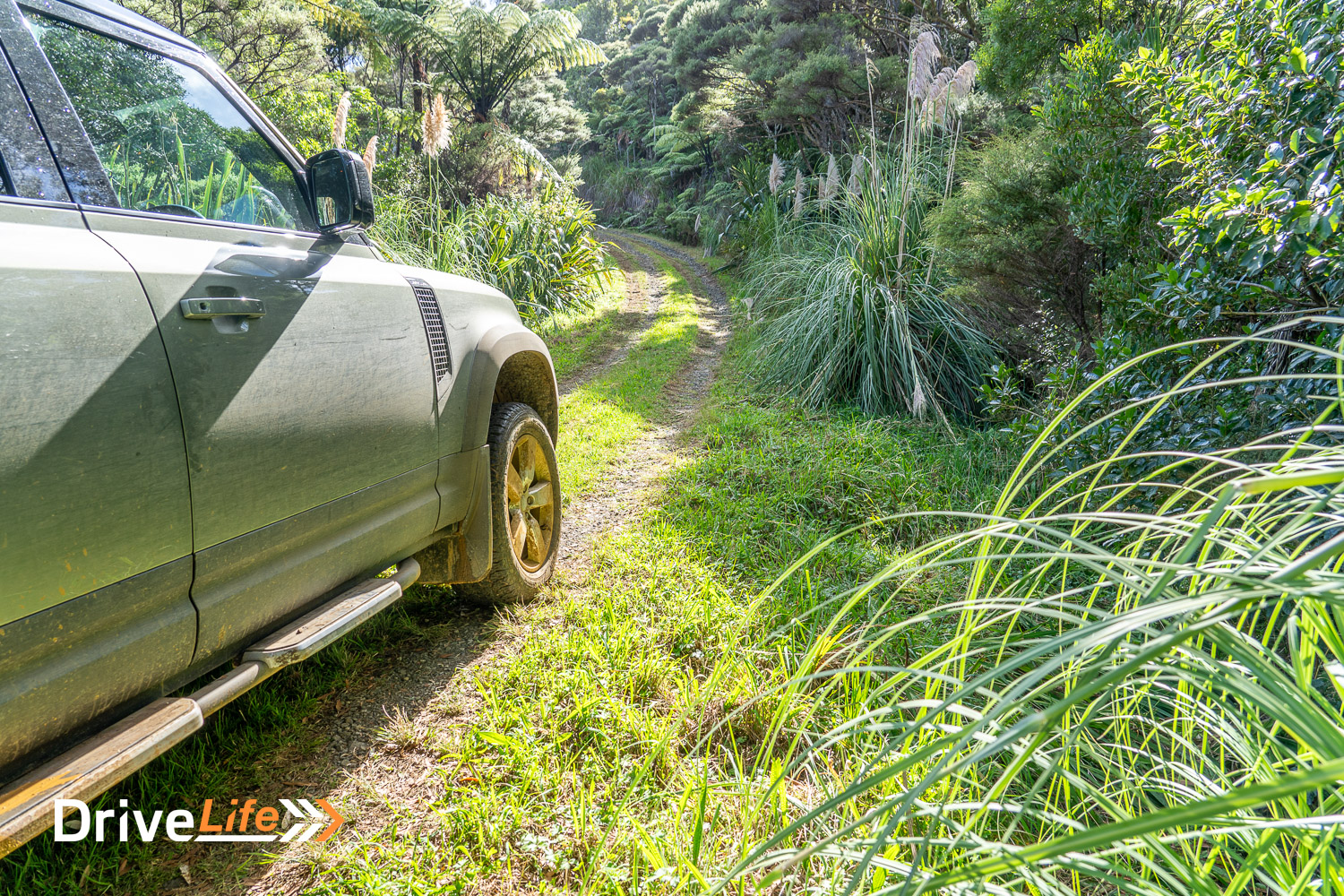
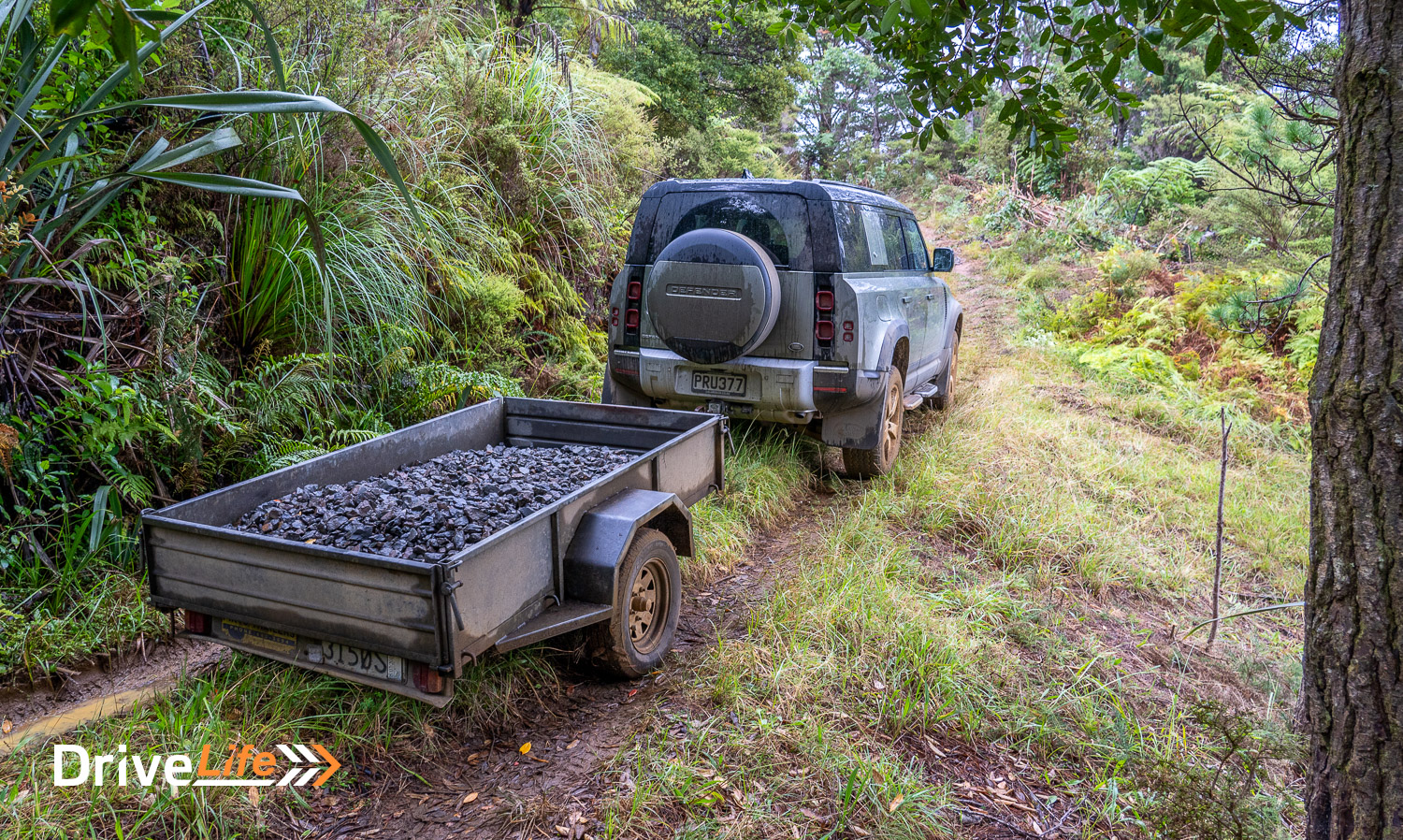
At one point, I got to the worst ruts in the road; these would need fixing ASAP, but the Defender didn’t blink an eye at them, with those high-profile Goodyear Wrangler tyres providing peace of mind that I wouldn’t get stuck. While I hoped I wouldn’t need it, I saw on one of the infotainment screens that the Defender can go to a wading depth of 850mm, impressive stuff. Some of this would be down to the car’s snorkel, I guess.
After getting to my bach, the Defender had mud all inside the wheel arches. It wouldn’t improve over the next week, and would only get worse. Still, this is what the car was made for.
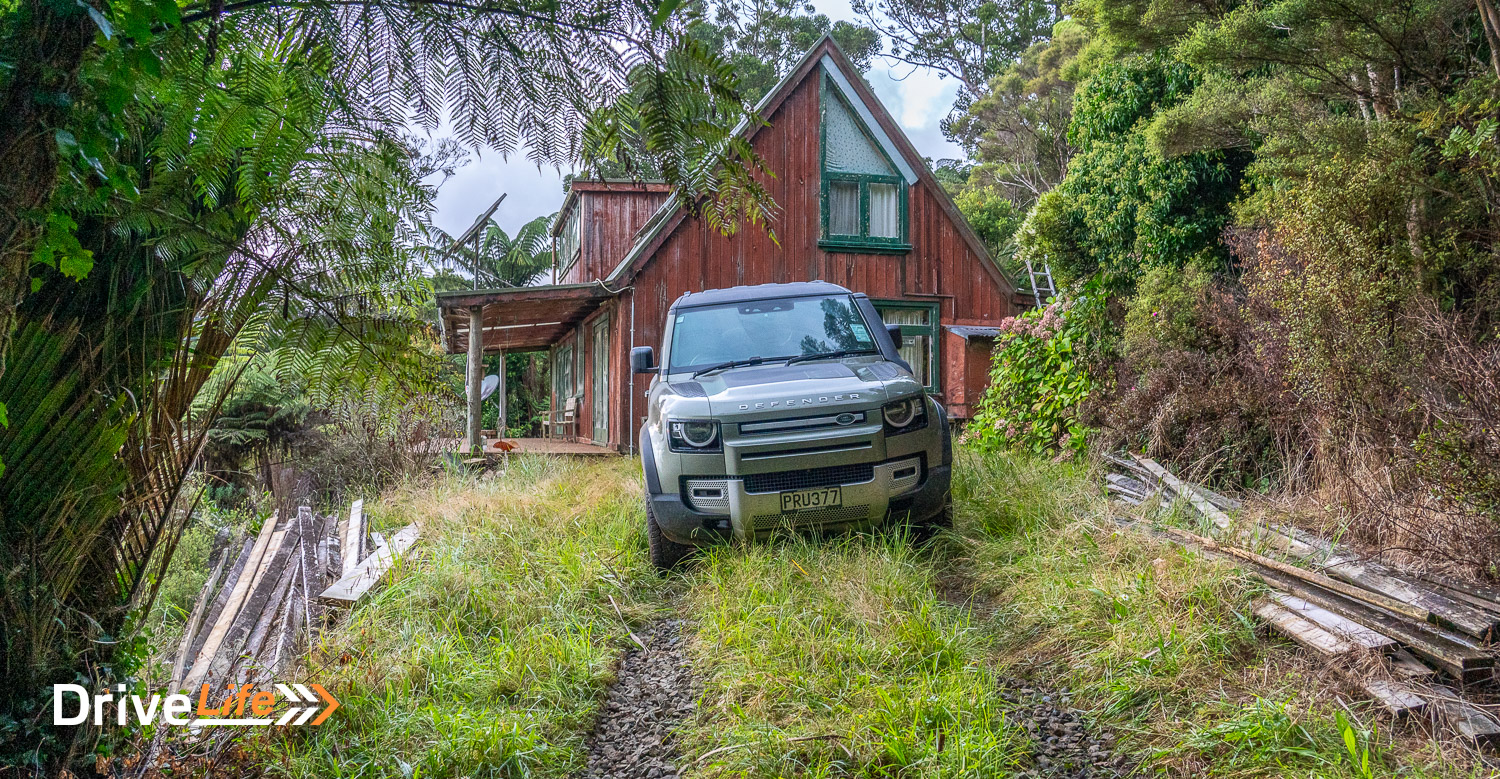
The next morning it was time to hook up the trailer and start getting loads of metal to fix the road. I love the little trailer icon that flashes on the dash when you have the trailer on, so you know the trailer indicators are actually working. A nice touch. Before heading up the hills from Ahipara, my fuel economy was sitting at 10.1L/100km – not too shabby for a 4WD weighing in at 2,249Kg. I’d be seeing how much more fuel the car would use after doing loads of metal and also towing a 2-ton digger up into the hills.
At the quarry near Ahipara, loading up with metal was easy, and the car self-levelled to make sure driving dynamics weren’t too much affected. Of course because quarry loader drivers like a laugh, the trailer had more metal on it than I really wanted. It made the trailer ride smooth but I still had some major hills to climb before I could empty it.
One of those hills is what we have named The Big Hill. Compared to the Auckland Harbour Bridge at 6 degrees climb, Big Hill is 18 degrees. At the bottom of the hill, I put the Land Rover into Neutral and then hit the ‘Low’ button. Seconds later the car’s gearbox was in low range, and I drove up the first hill effortlessly, and then Big Hill – drama-free as well. You can see in the drone footage that the 110 does spin the wheels here and there (with the digger on), but with electronics in 4WD vehicles is so advanced, it makes things like this a doddle.
After four full loads of metal (and emptying each one with a shovel), I was a lot more tired than the Defender. It handled today’s workout with ease but tomorrow would be a bigger test; I’m picking up a 1.7-ton digger that weighs in at 2-ton with its trailer – and would need to get this up The Big Hill as well.
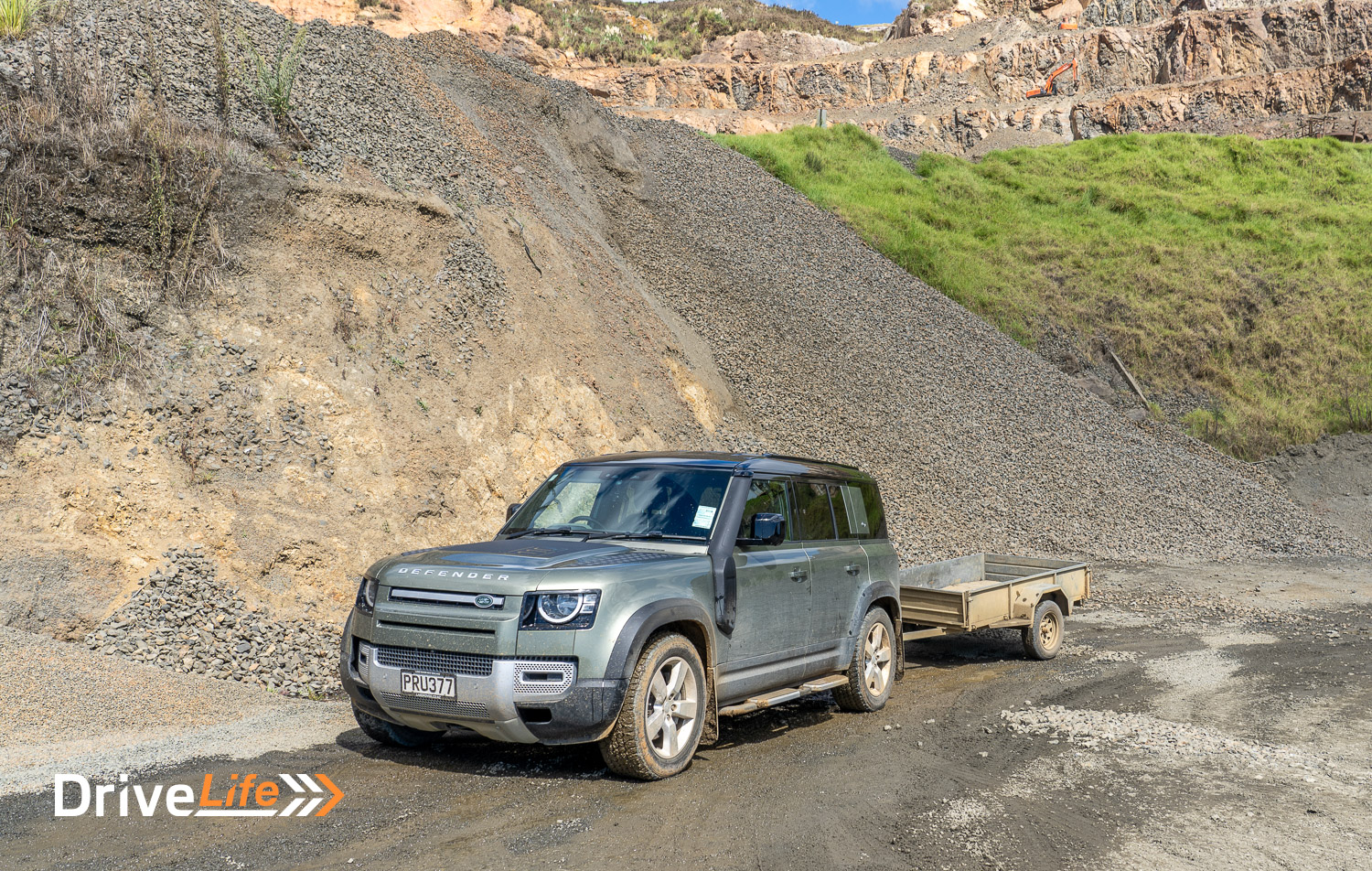
The next day it was a trip to Kaitaia Hire to pick up my digger. Was I excited about having a digger to play with? Totally. I had already checked out the tow-ball situation, concerned that if the digger’s trailer had the wrong size ball, I’d be stuffed for hooking it up. I needn’t have worried, as in the boot of the Defender was the smaller-sized tow ball. You can push a pin out on the towball on the car with something as simple as a key, and then switch the ball size over. Easy!
Digger trailer all connected up, I hit the road back to Ahipara, and then the climb above Shipwreck Bay. I was concerned at this point about braking power; I thought with weight of the digger and trailer would cause my braking distances to extend out quite a long way but I was wrong – the brakes still had plenty of power to cope with the extra load on the car.
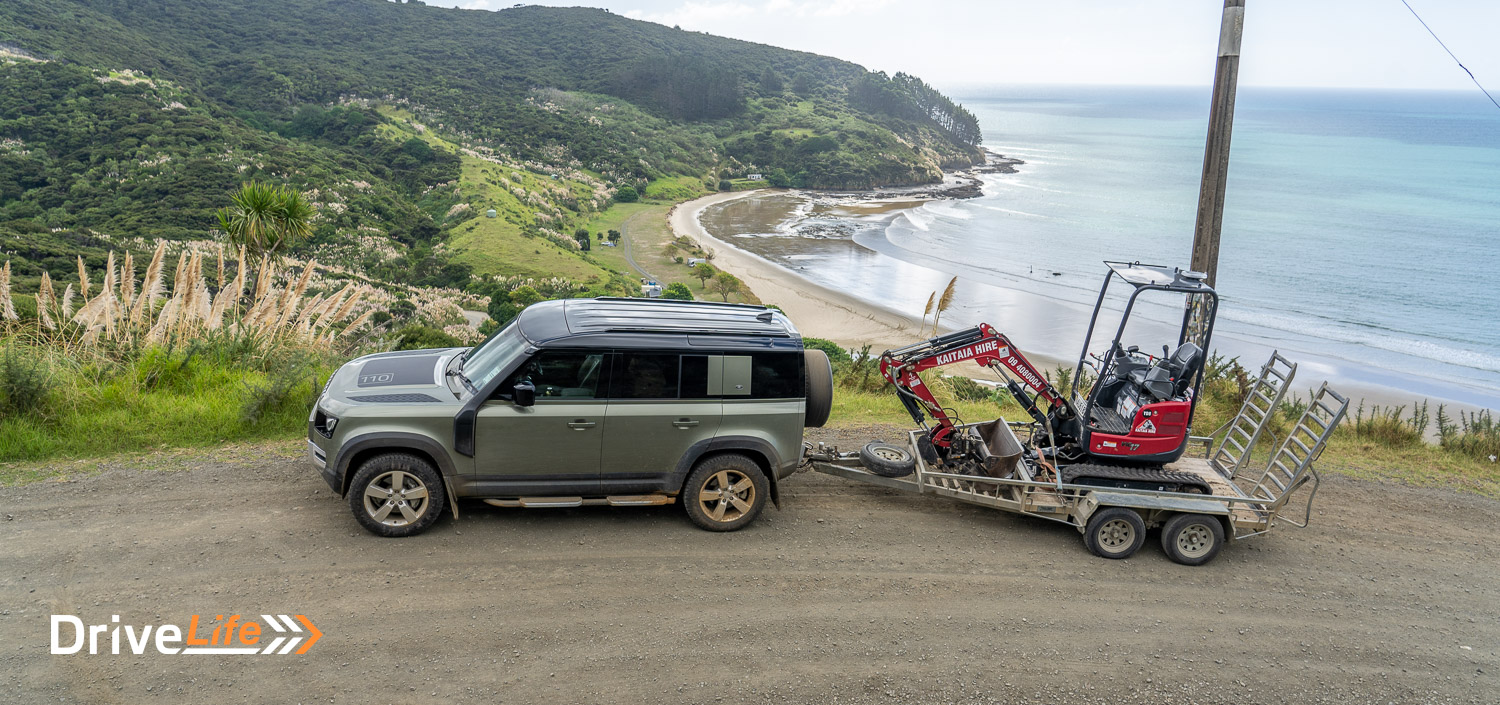
Leaving the road onto our track, I set the suspension to its highest (this would become an automatic brain function) and cruised slowly along our track. Getting to The Big Hill was the same as a trailer of metal; low range and gas it.
Side story: Years ago, I had a Range Rover as a company car. Living up in this wilderness at that time, having a Range Rover was gold. One day, we decided to get a load of metal on the trailer to spread on our track. We started to head up The Big Hill with the Range Rover in low range, and it ran out of grip. I had to stop halfway up and was about to engage the diff lock when the car started sliding backwards, the trailer of metal dragging it back down and sideways towards a cliff face (this was before all the trees grew up). I am not kidding. We looked at each other, trying to decide if this was the time to bail and let the car go over the cliff, when it slowed to a stop. It was very close, and we still talk about that to this day.
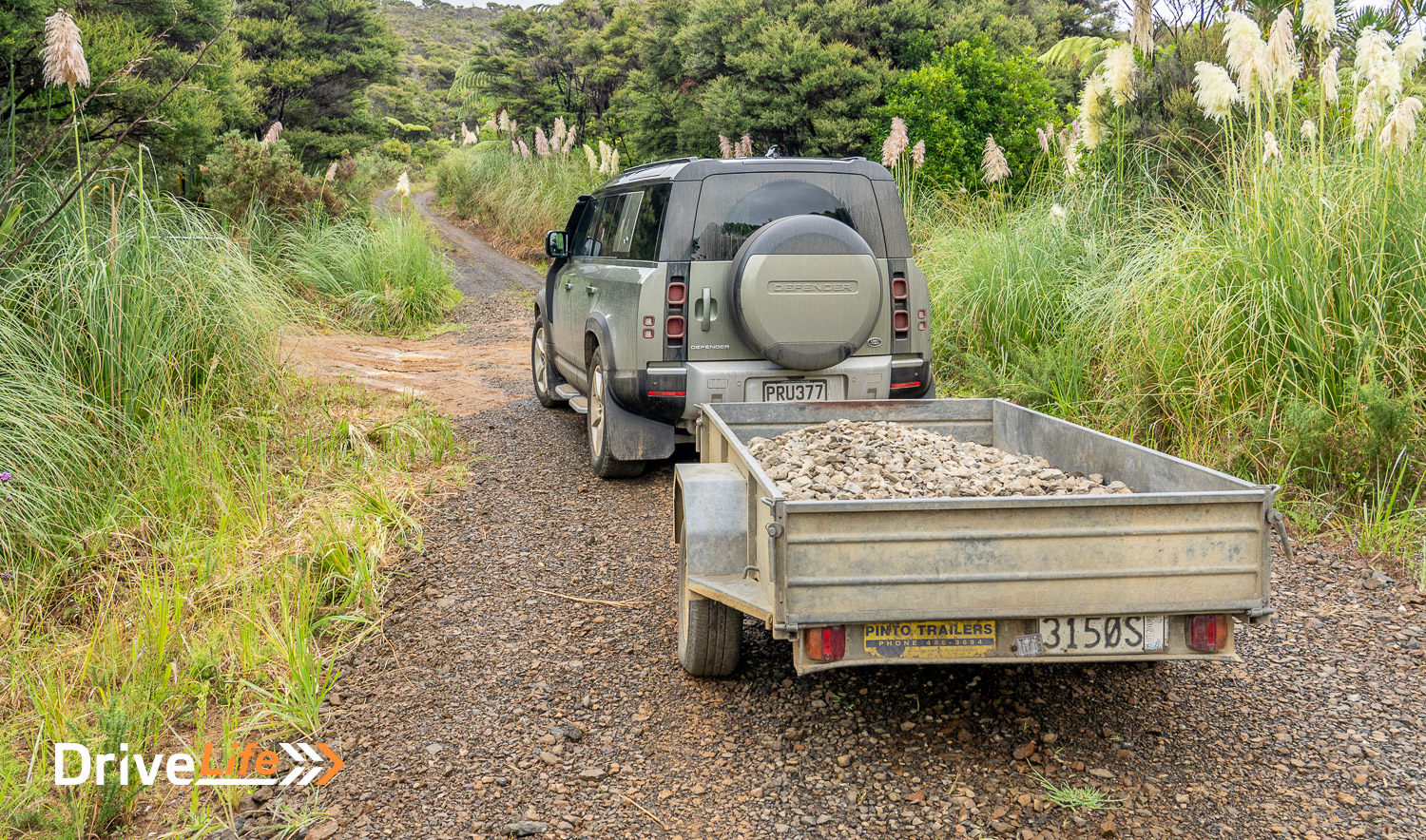
I say this as the trailer with the digger is a lot of weight on a car going up an 18-degree slope that’s got loose metal on it. The chances of slippage are pretty high. But again, electronics saved the day and I absolutely cruised up The Big Hill with no drama. Phew!
The next 14 hours were spent on the digger, breaking down trees and clearing drains, and then loading it back on the trailer, ready for another trip to Kaitaia the next morning to take it back. That morning, as I neared The Big Hill I had thoughts of the weight of the digger now pushing the Defender down that hill on the loose metal, and going out of control. Hill Descent Control was called for; I set it to 6km/h, took my foot off the pedals, and let the car do its thing. There was no reason for concern as the car cruised down the loose metal with zero loss of traction. I could see on the display which wheel was being braked at any time, as the car maintained its speed. It got boring so I used the cruise control speed adjustment button to increase Hill Descent Control to 10km/h, and that was a perfect speed for the hill.
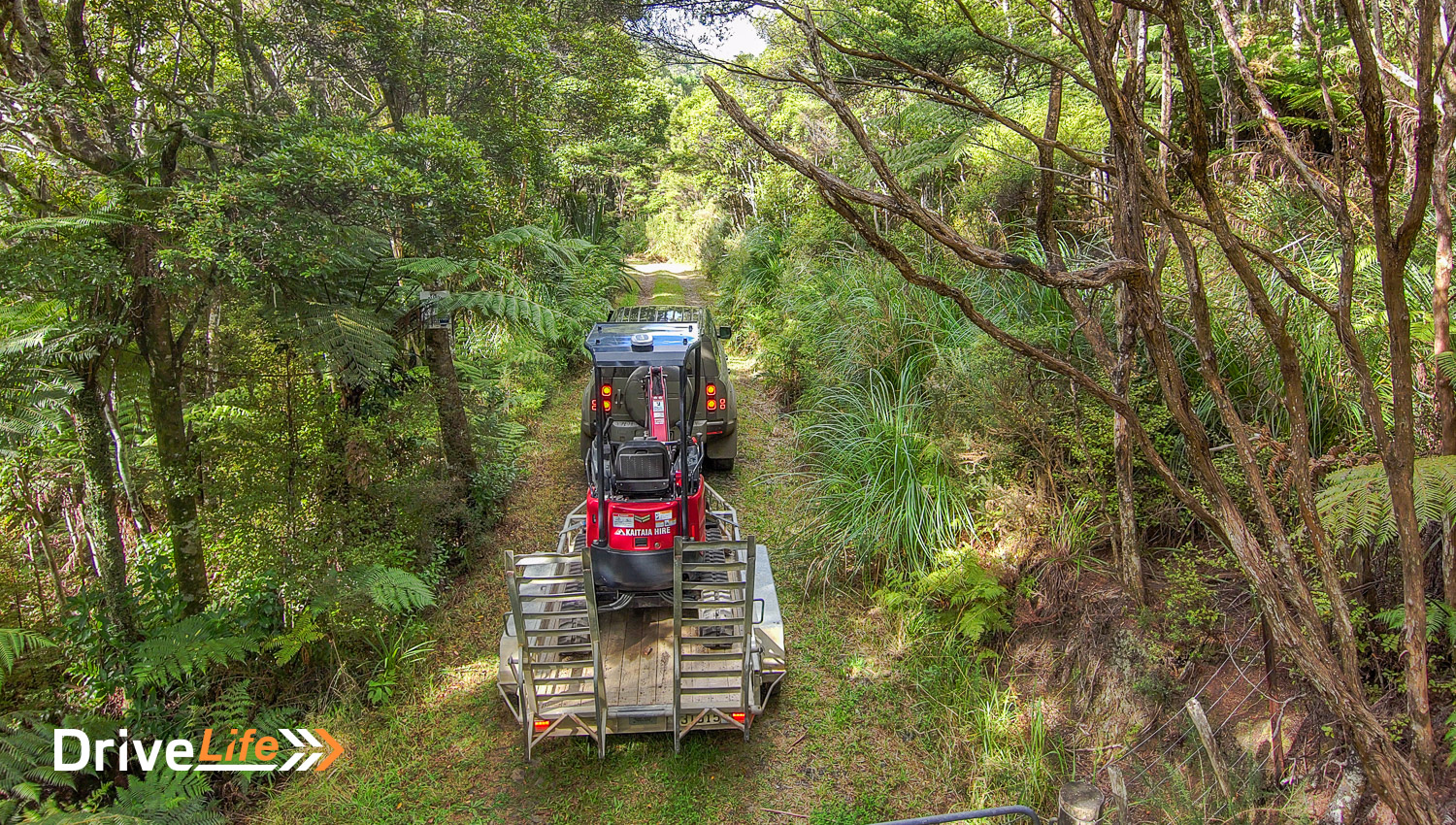
After dropping the digger off, it was back to the quarry for yet another load of metal, this one destined for my own steep driveway. Overnight it rained, meaning a trailer load of wet metal – and added weight. That morning, I pulled the Defender forward and backed the loaded trailer down the slick, muddy slope, ready to empty the trailer. But the slick mud meant little steering control so the trailer wasn’t going the right way. I would have to pull forward up this slope of slick mud so I could straighten the trailer. Honestly, I didn’t think this would work at all, but in low range, the Defender just drove forward up the slope with no wheelspin. To say I was very impressed is a huge understatement.
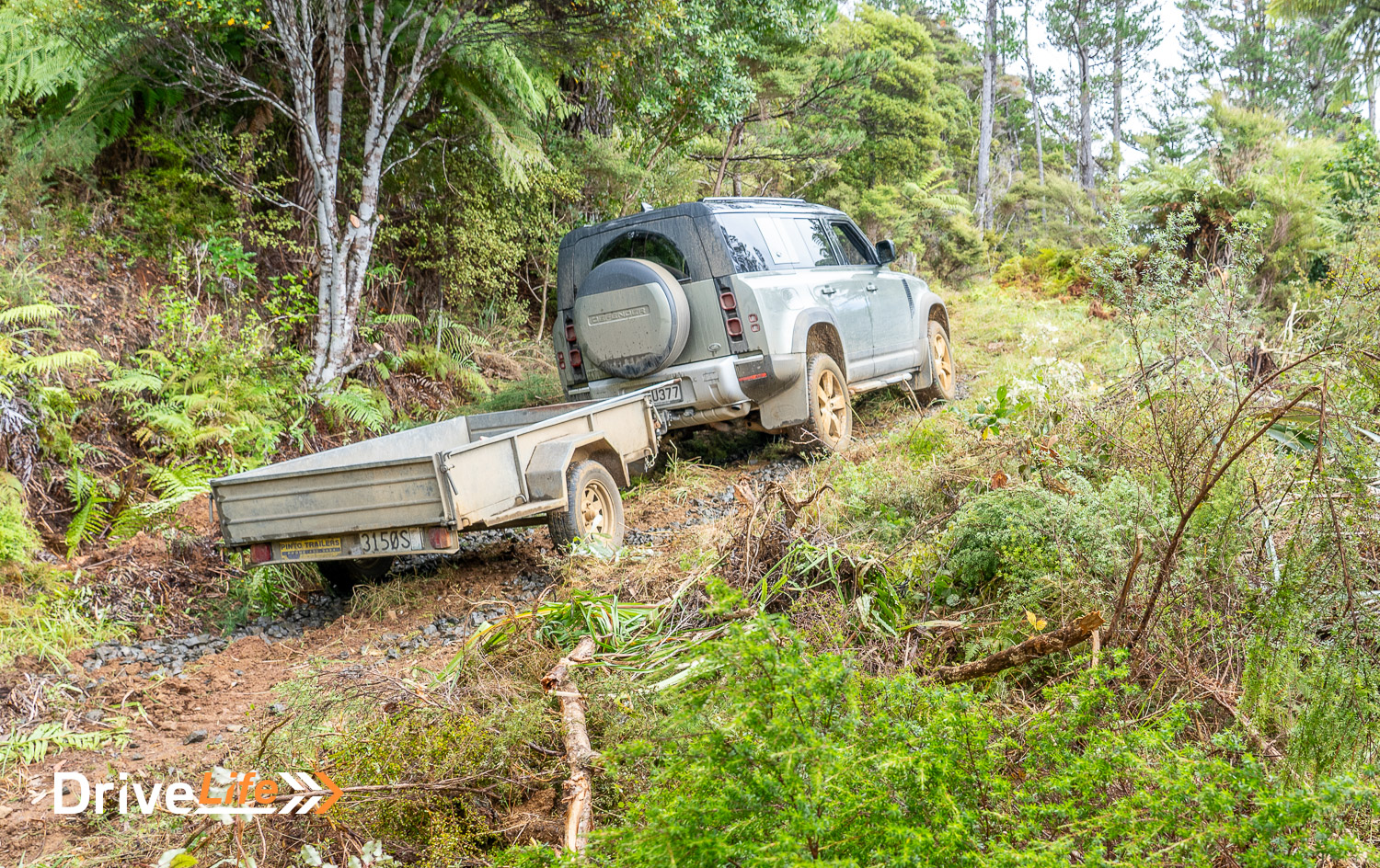
After my final load of metal, the Defender’s fuel consumption was sitting at 12.4L/100km, a figure I felt was very reasonable for the amount of towing of heavy loads up hills and on terrible tracks. At the end of my week working on our track of the road, the Defender nailed everything I threw at it.
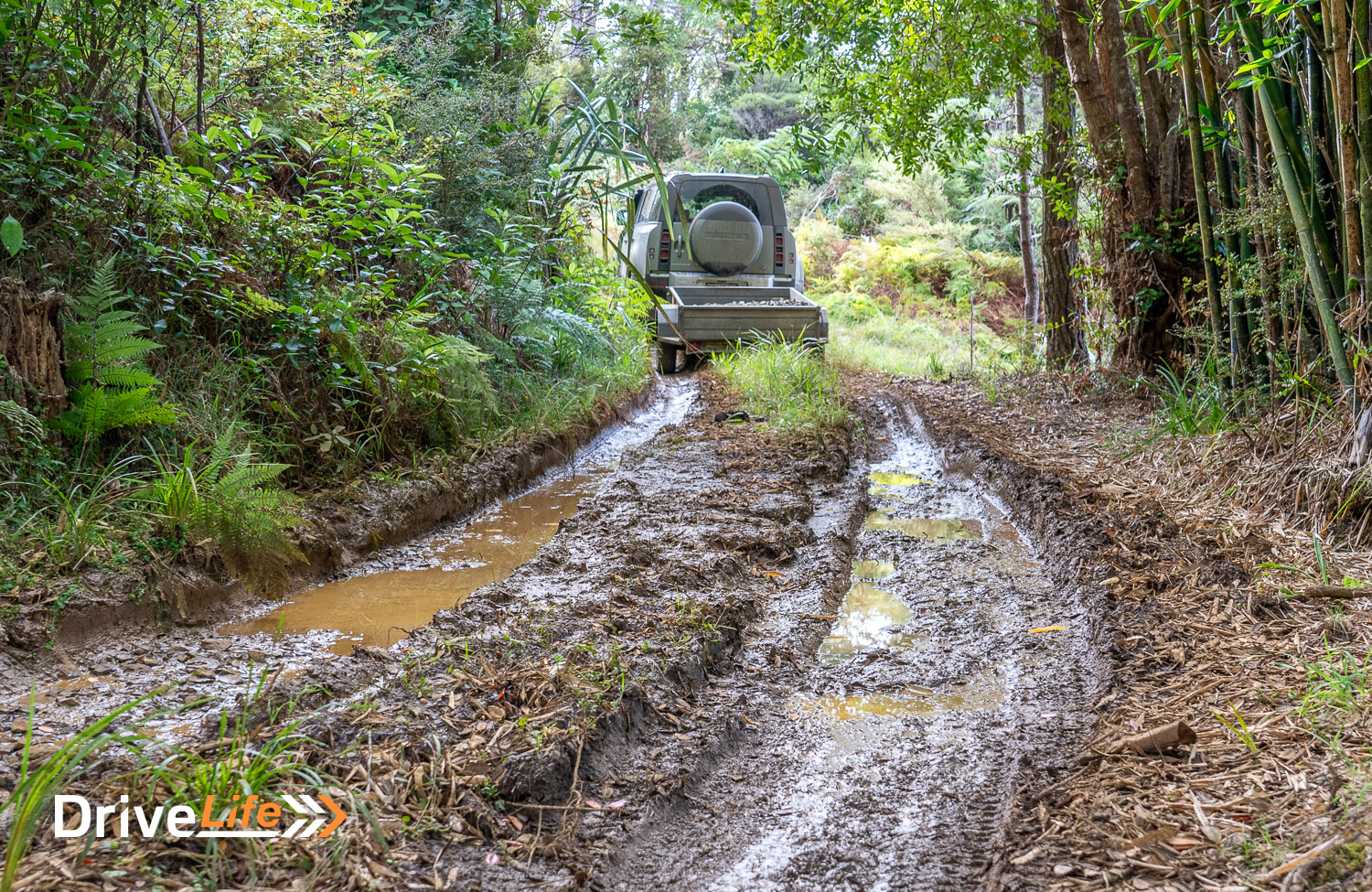
It was time to do the 360km drive back to Auckland, this time taking the Ahipara-Broadwood-Mangamuka road. There was almost no traffic using this route, so it’s far more preferable to use instead of SH10, until they finish fixing the latest round of slips over the Mangamukas on SH1.
Since there was little traffic on my alternate route, that meant I could give the Defender 110 its head now and then, and actually test out its handling. It shouldn’t handle well at all, right? After all, it’s a big, 2,249kg chunk of metal that sits way up off the ground and has Goodyear Wrangler tyres. Well, again, I was impressed. With air suspension controlling everything, it sits well and is relatively poised and composed on tighter corners. Grip wasn’t really an issue for me, and while there is some body roll it’s nowhere near as bad as you’d expect. Does this make the Defender the perfect all-rounder?
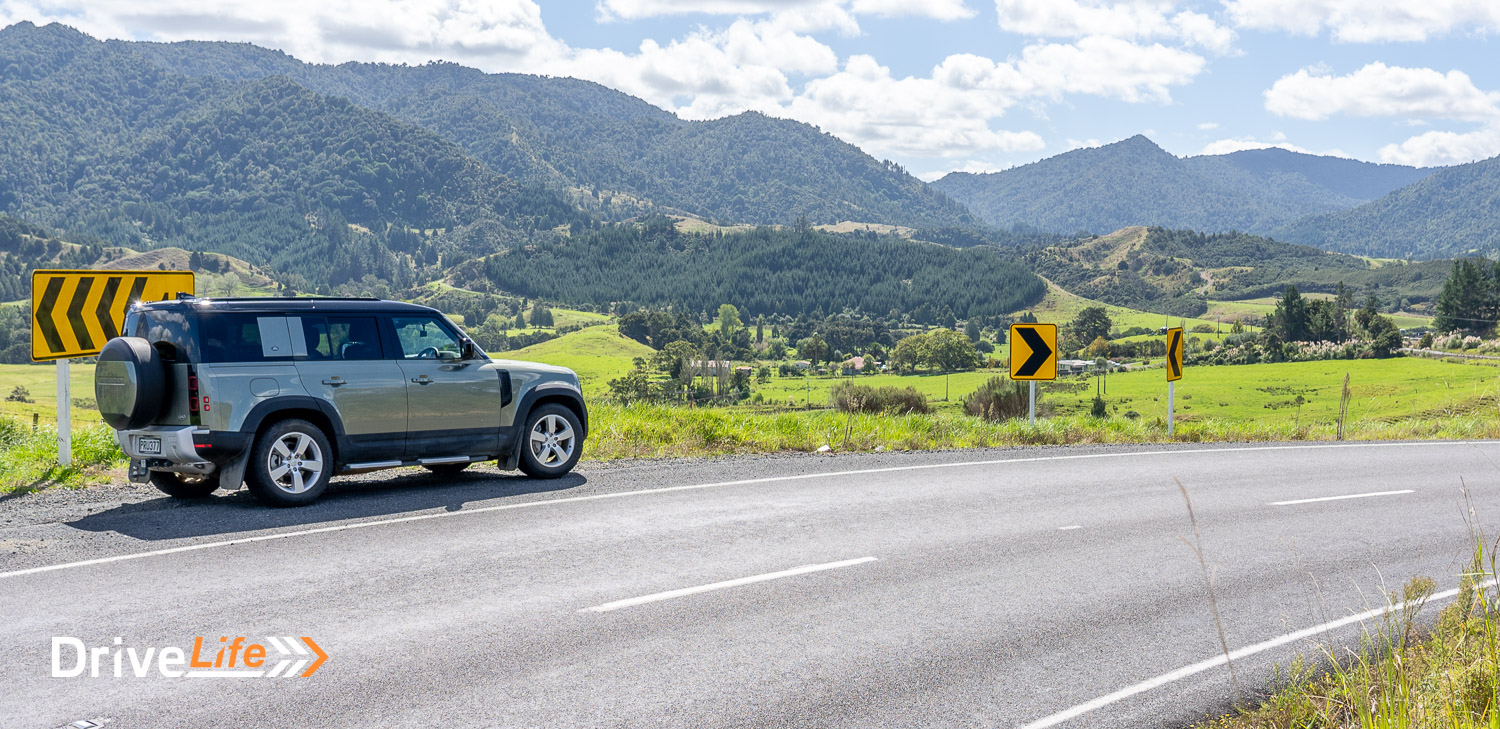
The 8-speed ZF automatic transmission is superb, always choosing the right gear at the right time, and changes are always smooth and quick. Offroad it was excellent, too. Absolutely nothing to complain about in the transmission department. It did feel weird pressing a button instead of moving a lever to access low range, but it was simple and quick.
Driving back to Auckland on SH1, the adaptive cruise control worked perfectly and is one of the smoother units out there. I used the speed limiter now and then too, and was very happy to see it slows the Defender down when travelling downhill. This is only the third vehicle I’ve tested that does that, and it helps with not getting a speeding ticket.
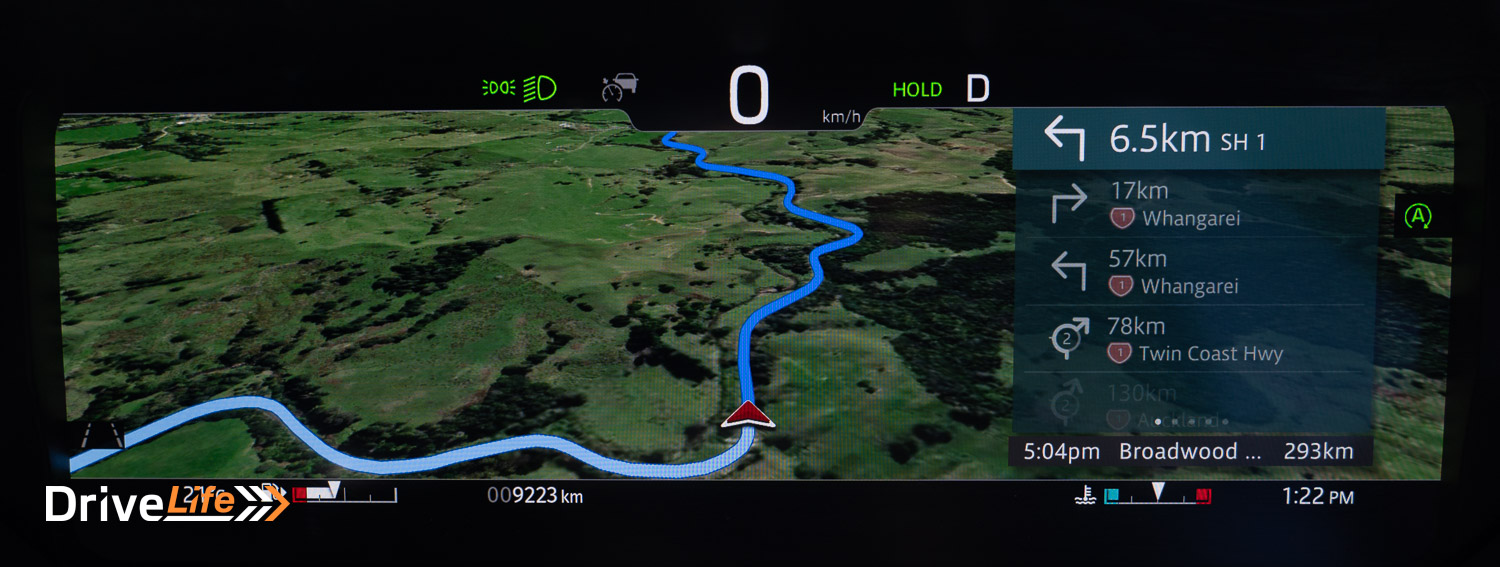
Another highlight of the Defender I had forgotten about is seat comfort. Long trips are a great way to test out a car’s seats, and those in this car are excellent. I made use of the Defender’s heated seats now and then too, and love how you simply push the AC dial on your side of the car to bring up the heated seat settings, then turn the dial to the right to increase the temperature. It’s ergonomic brilliance. Well, except for the fact that along with some little red heat wavy things on the dial, there are also blue wavy things to indicate you turn that same dial left to turn on seat ventilation. But our model didn’t have ventilated seats – but still had the blue wavy bars. It feels like Land Rover is telling us, “Well, if you had just worked a little bit harder, you could have had this option too.”
Arriving back in Auckland, I felt fresh and ready to drive back again. My end fuel consumption after driving 1,200km was sitting at 11.7L/00km. That’s a number I could live with, considering what I had put the car through. It is a 6-cylinder twin-turbo diesel hauling well over 2 tons around, after all.
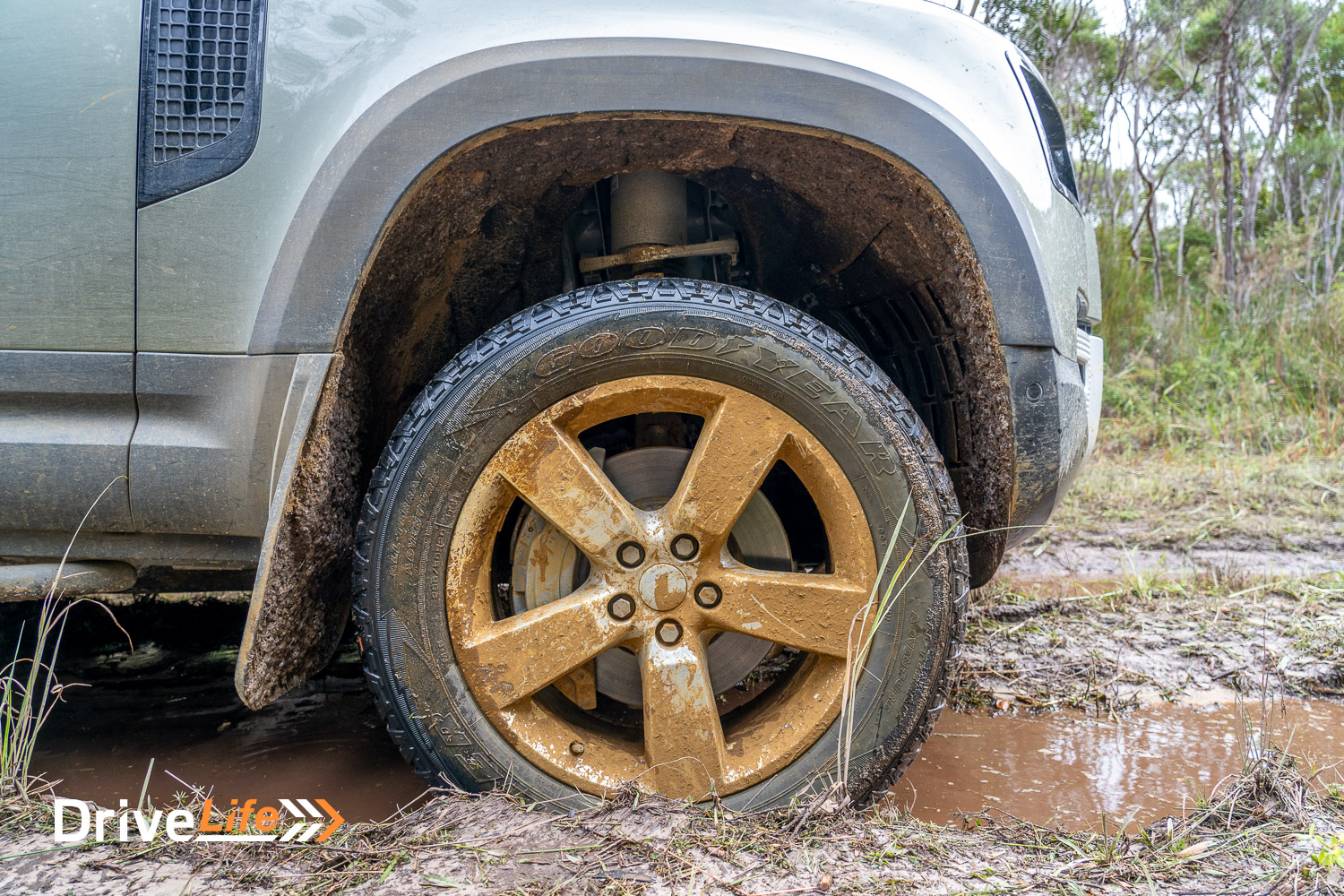
If there’s one last thing to cover, it’s the car’s rubber mats – there is no carpet in the car at all. My initial impressions were of cost-cutting, but after getting back to Auckland I pulled the mats from the car and hosed all the mud off them – perfect!
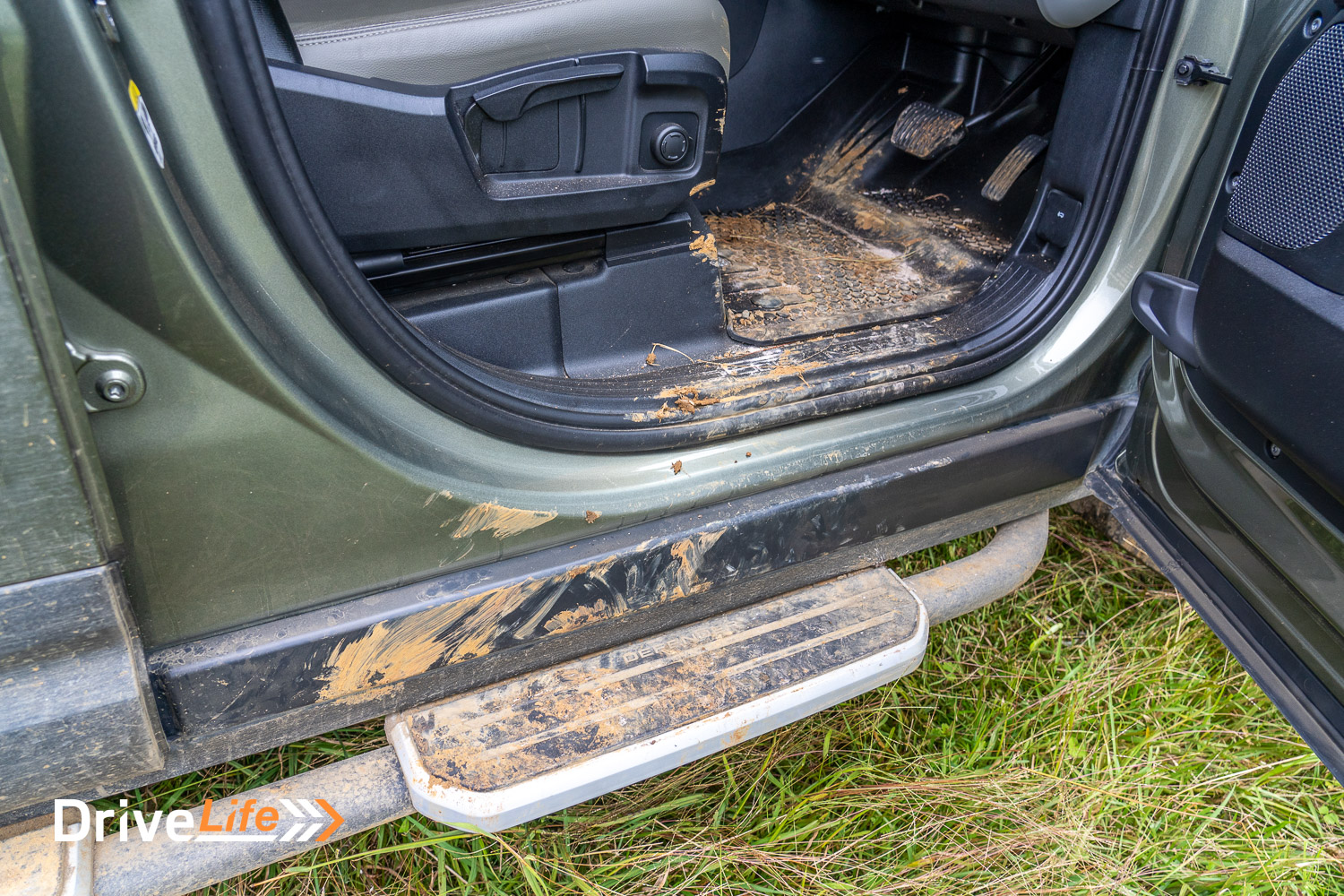
At the end of the trip, I had chosen the right vehicle for the job. I was expecting the Defender 110 to be good on the tracks I would be taking, but the way the car handled towing heavy loads blew me away – it far exceeded my expectations. It truly is a car you could live with, if you could have just one car. It’s total awesomeness in a stunning design.
Many thanks to Land Rover New Zealand for allowing us to get one of their cars muddy inside and out. It certainly proved itself.
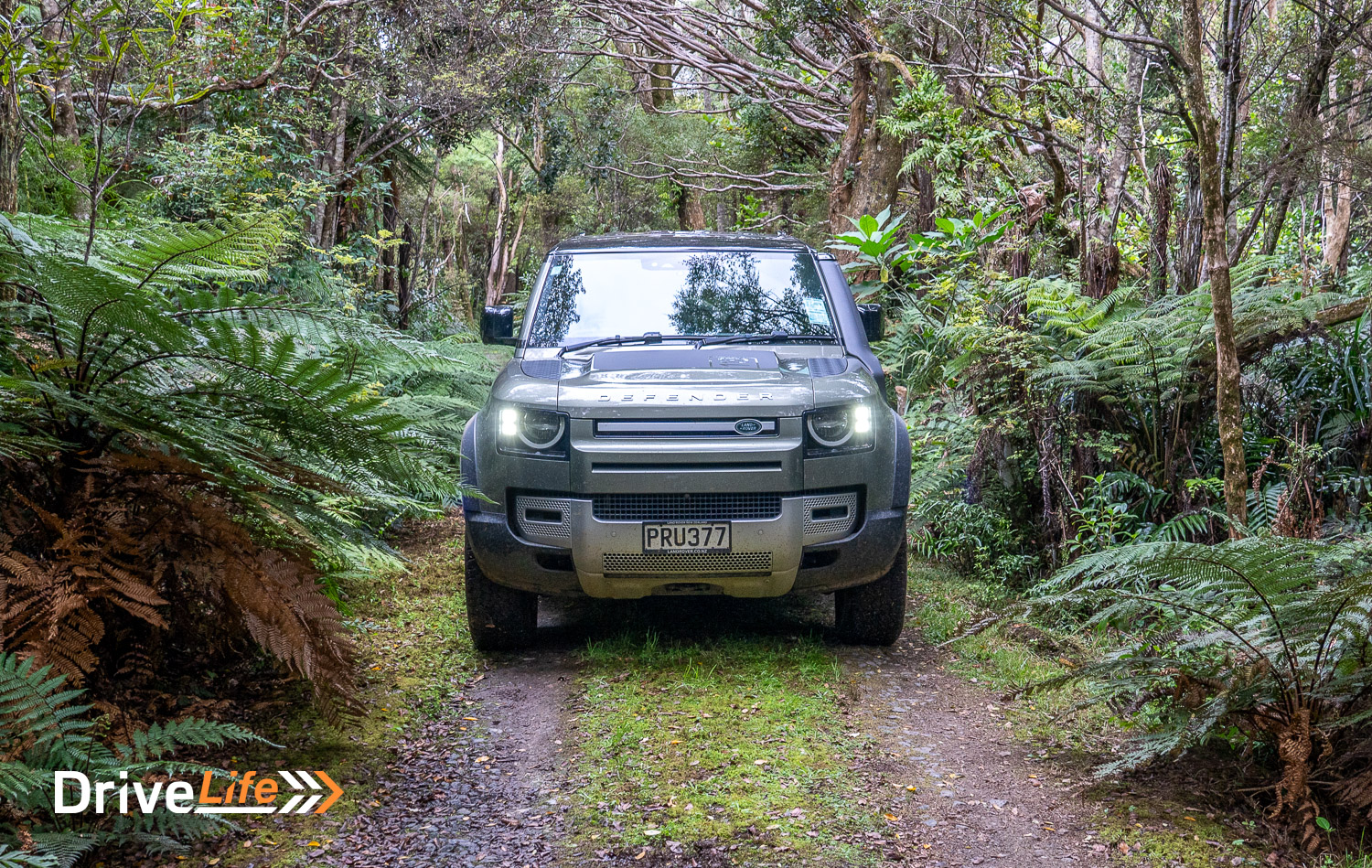
2023 Land Rover Defender 110 D300S – Specifications
| Vehicle Type | Large SUV |
| Starting Price | $139,000 |
| Price as Tested | $139,000 |
| Engine | 3.0 Litre 6-Cylinder Twin-Turbocharged Diesel MHEV |
| Power, Torque kW/Nm | 221/650 |
| Transmission | 8-speed automatic |
| Kerb Weight, Kg | 2,249 |
| Length x Width x Height mm | 5018 x 2008 x 1969 |
| Fuel tank capacity, litres | 89 |
| Fuel Economy, L/100km | Advertised Spec – Combined – 7.9 Real-World Test – Combined – 11.7 Low Usage: 0-6 / Medium Usage 6-12 / High Usage 12+ |
| Towing Capacity Kg, unbraked/braked | 750/3,500 |
| Turning circle metres | 12.84 Small: 6-10m / Medium 10-12m / Large 12m+ |
| Warranty | 3 years or 100,000km |
| Safety information | ANCAP Rating – 5 stars – Link Rightcar.govt.nz – 5 Stars – PRU377 |


